Propellor-driven Motorcycles
|
| |
This gallery deals with propellor-driven cycles where the propellor is turned by an engine. Pedal-driven propellors are in this gallery.
It is explained on the propellor car page that a propellor is very inefficient at low speeds. This did not (if they knew it) deter the constructors of these machines. The impracticability of mixing up pedestrians and whirling propellors is obvious.

PROPELLOR-DRIVEN MOTORCYCLES
 |
| Left: The Archdeacon/Anzani propbike: 11 Sept 1906
The Archdeacon/Anzani propbike is relatively well-known. Although his name is associated with this machine, motorcycle racer Alessandro Anzani was in fact simply selected to test the aéro-motocyclette, as it was called. It was built for for Ernest Archdeacon, (in the suit at left) an early promoter of the automobile and aviation; despite his name he was a Frenchman. It was built for propellor testing and was NOT supposed to share the road with pedestrians. The frame and motor were built by Buchet, for whom Anzani worked; he was in the process of leaving to set up his own company.
In July 1909, engines by Anzani became famous after powering Louis Blériot’s airplane for the first flight across the English Channel.
Picture courtesy of Reg Winstone
|
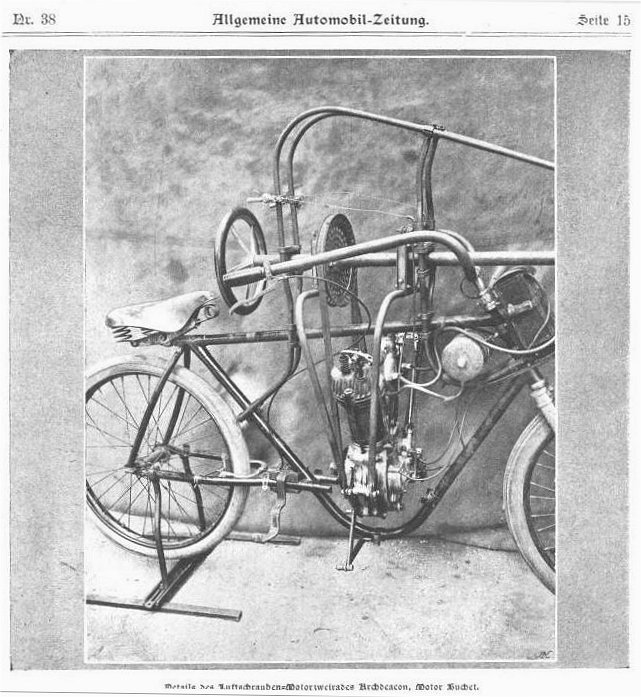 |
| Left: The Anzani propbike: 1906
The Buchet V-twin engine drove the propellor at a speed less than the engine, via 1.5 metres of belting. The round thing at the right is the petrol tank.
Although the machine was built for propellor-testing there is no sign of any instrumentation, not even a speedometer. Presumably performance was measured solely by stop-watch timing it over a measured distance.
The engine gave 6HP, according to Wikipedia,
Picture courtesy of Reg Winstone
|
 |
| Left: The Anzani propellor cycle: 1906
The machine was built for Ernest Archdeacon, (in the suit) an early promoter of the automobile and aviation, for propellor testing. Surely no could have thought this was a practical vehicle for use in busy streets...
|
 |
| Left: The Anzani propellor cycle: 1906
This is a rather better picture of the Anzani bicycle. The engine is a V-2, driving the propellor by belt and pulleys that give a speed reduction.
|
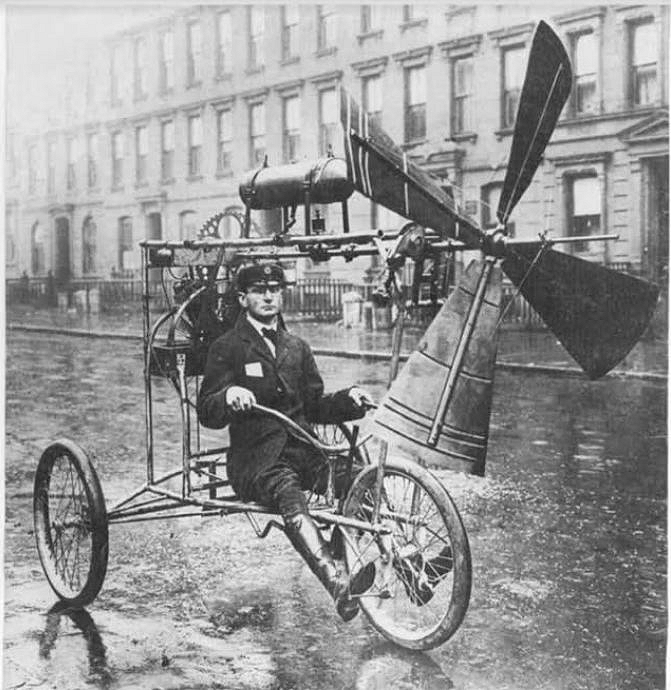 |
| Left: Unknown propellor Tricycle: 1910s?
This tractor-propellor tricycle has not been identified, an image search yielding nothing.
The crude prop design suggests a time before the First World War. The driver seems to have his feet in stirrups either side of the front wheel. It looks as though the handlebars are connected to a link arm under the driver's thigh that connects to a swivelling rear axle.
The engine is a V-twin driving a big chainwheel just behind the driver's head.
I suggest the buildings behind look English rather than European.
The snag with a tractor propellor is that you sit in the full force of the backdraught. It is probably no coincidence that apart from the Anzani test rig above, all the prop-bikes on this page use pusher propellors.
|
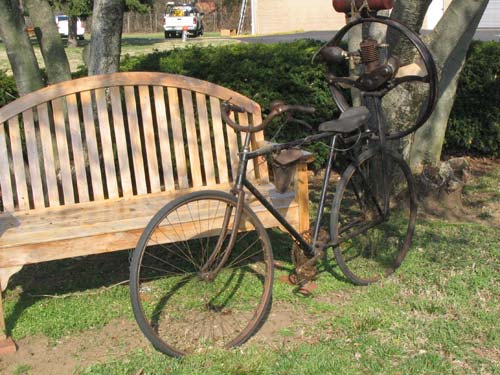 |
| Left: Peugeot propellor bicycle: 1920s
This machine was built by S.A. des Automobiles Peugeot of France. It had single-cylinder two-stroke air-cooled SICAM engine of 100cc, which sounds rather less than potent. The pedal drive to the rear wheel was retained. It looks somewhat improvised, and certainly not meant for production as is. It may have been just a bit of fun..
At least this propellor has something like a prop-guard, but there do not appear to be any brakes at all. The left-hand brake lever seems to have been repurposed as a throttle control.
A reverse image-search with Google reveals nothing.
|
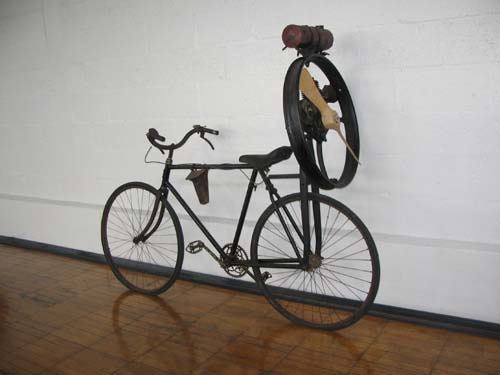 |
| Left: Peugeot propellor bicycle: 1920s
This picture gives some more mechanical details. The prop is twin-bladed, the rather small fuel tank is perched on top of the prop-guard. The engine seems to be mounted on a re-purposed motorcycle front fork.
The chain from the pedals seems to be missing here, though it is in place in the outdoor picture above. There appears to be no way for the engine to drive the rear wheel directly.
This machine is at the Lane Motor Museum at Nashville TN, USA.
|

 |
| Left: English propellor-tricycle: 1930
Here is another prop-tricycle; this one is powered. Unlike the other two prop-tricycles above the two wheels are at the front, requiring the extra complication of Ackermann steering.
It is believed to have been built by Hardings of Bath, who for many years made invalid carriages. It is in the Lakeland Motor Museum, in England.
|
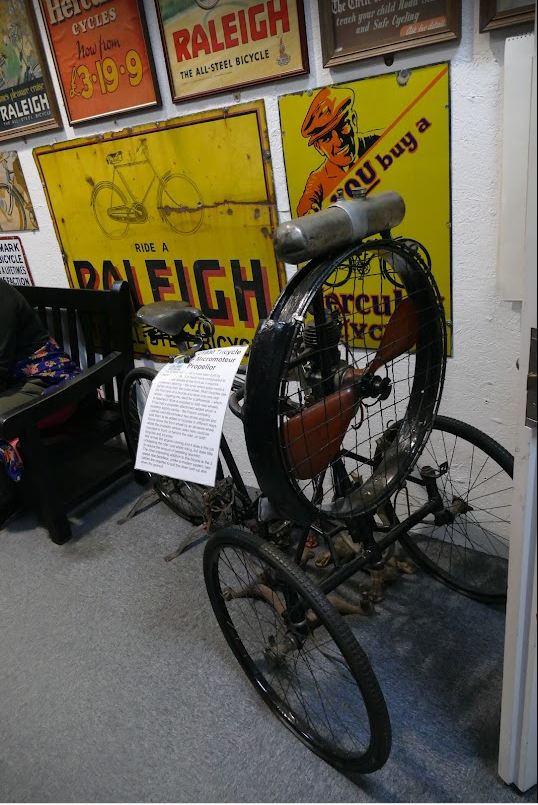 |
| Left: English propellor-tricycle: 1930
According to the attached notice, the engine is a Labinal Micromoteur, manufactured in Paris from 1922 to 1928.
|
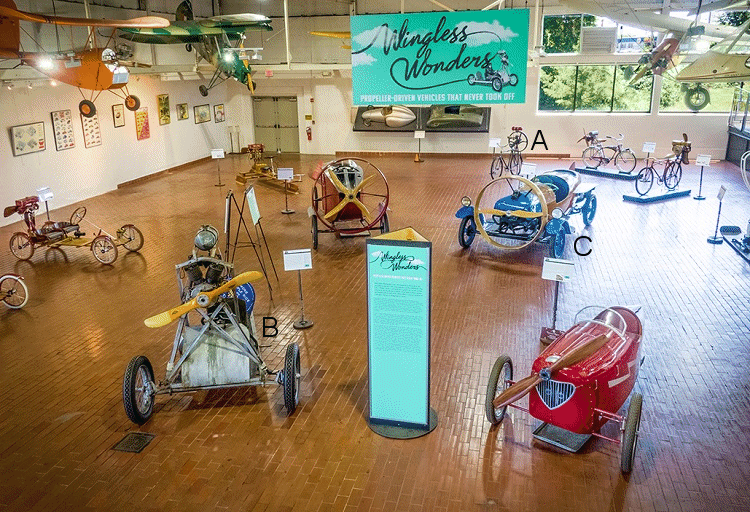 |
| Left: Lane Motor Museum 'Wingless Wonders' hall
This hall is part of the Lane Motor Museum at Nashville TN, USA.
So far only the following vehicles have been identified:
A= Peugeot propbike 1920s
B= Jameson Wind-Wagon 1929
C= Helicron propcar 1932
D= L'Eclair propcar 1930
E= Auto Red Bug 1924
If anyone can identify the remaining vehicles it would be much appreciated.
You can see the original picture here.
|
DE DION BOUTON PROPELLER BICYCLE: 1920's
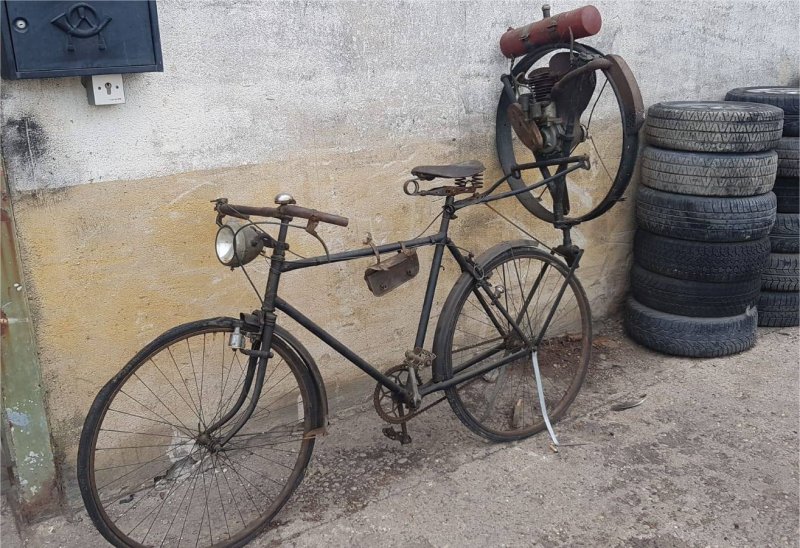 |
| Left: De Dion propbike: 1920s
At first sight this looks like the Peugeot bike above, but it is in fact a different design. The propellor and engine mounting are quite different. It is powered by a Motobecane MB3 175cc two-stroke engine.
It is unknown why it was built, but highly unlikely it was meant for production.
Some more info here.
Apparently it was recently sold.
|
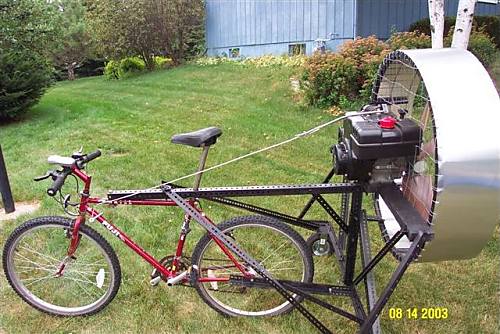 |
| Left: The Fanbike: 2003
A more recent propellor-driven bike, with a shrouded pusher propellor this time. Built by John Wiltbank.
Note the two extra little wheels at the back, which stop the weight of the engine pulling the bicycle over backwards. Not an elegant solution.
|
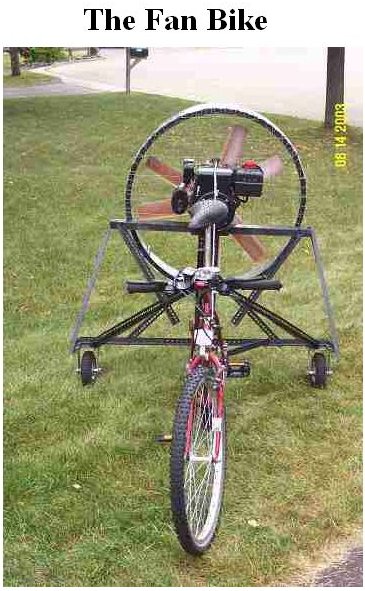 |
| Left: The Fanbike: 2003
Note the odd six-bladed propellor. It is presumably not a counter-rotating design. Six-bladed propellors have been used on some aircraft (eg the C130 Super Hercules) but always with equal spacing.
|
 |
| Left: The Thrustpac: 2006
The Thrustpac is a ducted fan driven by a small IC engine. It is intended to provide power on bicycles, canoes, skis etc. Once again the propellor is fully shrouded for safety.
The Thrustpac is manufactured by a company called Pacific Wind. Seems like a well thought-out product.
|
 |
| Left: Aerobicle add-on propellor power unit: 2014
This is a representative of a new trend; the electric propbike. Strangely, Aerobicle don't seem to have a website.
Maximum speed is said to be up to 40 km/h on flat ground without pedaling. The 2.4 kgm battery allegedly gives a range of over 100 kilometers on mixed terrain.
More info here.
|























